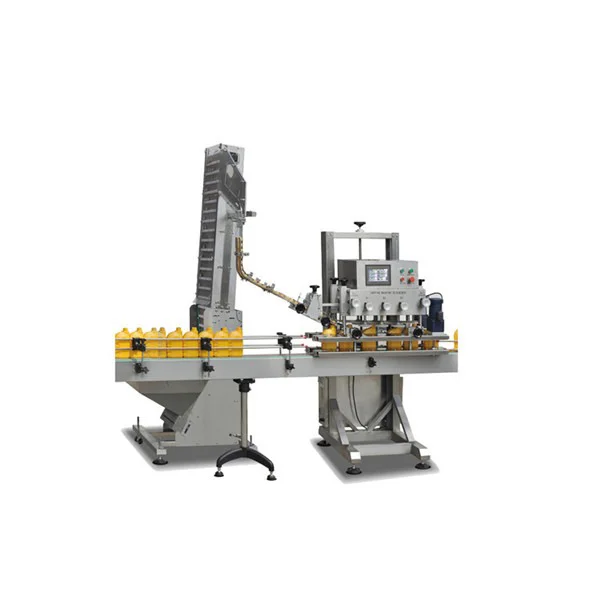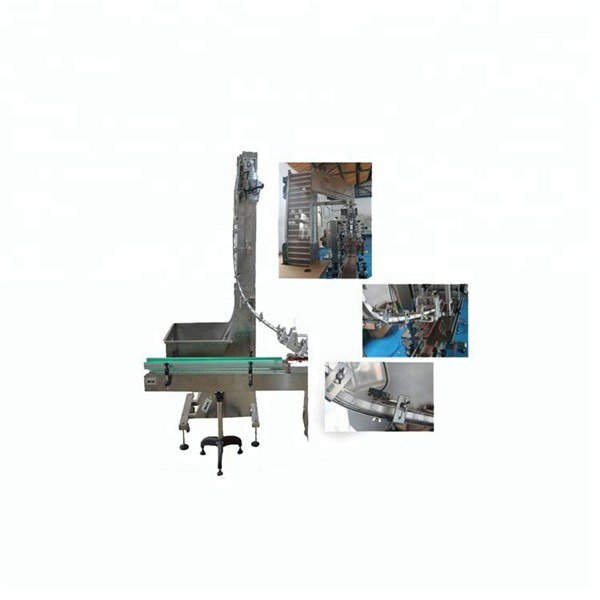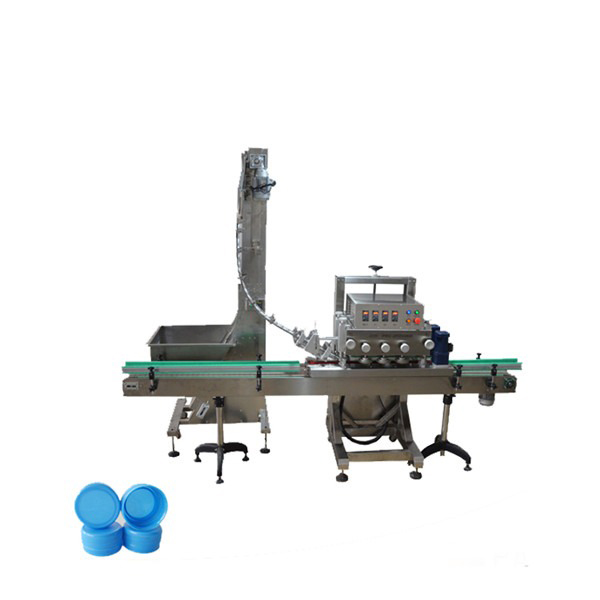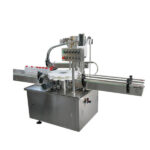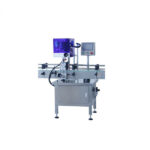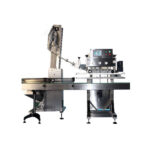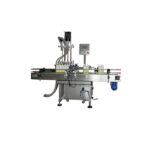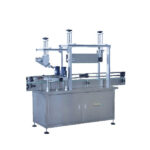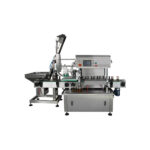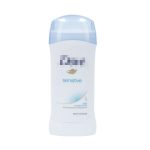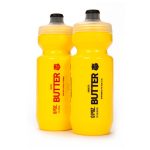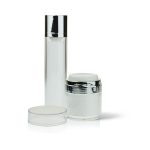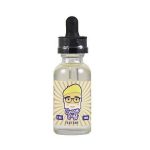Automatic Spindle Capping Machine
Automatic capping machine is flexible, durable and works with most containers and caps includingflat caps, sport caps, metal lids and many others.The machine has practicability in field of pharmaceutical, pesticide, chemical, foodstuff etc. It is real ideal equipment for bottle screw capping, also applied to seal aluminum cap, the ft proof cap, screw-thread cap, ROPP cap etc. It's built on a heavy duty, tig welded, stainless steel frame with anodized aluminum plate construction to provide durability in almost any packaging environment. The modular design lets you start with just a cap tightener and easily add capabilities when you need them.
VKPAK spindle capping machine is suitable for spindle screw caps, locked caps, and spray caps and so on. The caps can be metal , plastic.
Description
We manufacture our Automatic Capper for liquid packaging lines here in our facility. It is flexible, durable and works with most containers and caps including flat caps, sport caps, metal lids and many others. It’s built on a heavy duty, tig welded, stainless steel frame with anodized aluminum plate construction to provide durability in almost any packaging environment. The modular design lets you start with just a cap tightener and easily add capabilities when you need them.
Packaging Type: Cartons
Packaging Material: Wood
Type: Capping Machine
Condition: New
After-sales Service Provided: Free Spare Parts, Field installation, commissioning and training, Field maintenance and repair service, Online support, Video technical support, Engineers available to service machinery overseas
Place of Origin: Shanghai, China
Brand Name: VKPAK
Voltage: 220v 50/60hz
Application: Beverage, Chemical, Food, Medical, Commodity, Machinery & Hardware, Apparel, Textiles
Weight: 500kg
Automatic Grade: Automatic
Driven Type: Pneumatic
Dimension(L*W*H): 1060*900*1600MM
Applicable Industries: Hotels, Garment Shops, Building Material Shops, Manufacturing Plant, Machinery Repair Shops, Food & Beverage Factory, Farms, Restaurant, Home Use, Retail, Food Shop, Printing Shops, Construction works , Energy & Mining, Food & Beverage Shops, Advertising Company
Machine Name: Capper Machine
Machine Type: Fully-automatic
Material: Stainless Steel
Capping speed: 30~200b/m
Capping type: Screw Capping Locking
Capping rate: 99%
Color: Silver
Packing: Long Distance Exported Wooden Case
Technical Parameter
| Automatic Capping machine | |
| Cap Diameter | 20-120MM |
| Bottle Height | 45-460MM |
| Speed | 60-200BPM |
| Voltage | 220VAC |
| Power | 1600W |
| Air Pressure | 0.6MPA |
| Weight | 500KG |
| Dimensions | 1080*900*1700 |
| Option | Cap Sorter |
Detail Images


Main Features:
- Power height adjustment
- Gripper Belt height and width adjustment
- Spindle Wheels Spindle Wheel adjustment knobs, with lock nut hand wheel
- No change parts required for a wide range of containers
- Sanitary 304 stainless steel drive shafts and adjustment support shafts
- Timing belt power transmission for Spindle Wheels
- Bottom screw changeover on Spindle Wheels
- 1/2” aluminum mounting plates and 1/2” hard coat anodized supports on Cap Feed Chute
- Removable dual gripper belts
- Trigger spray cap rails
Work Process
Like any person or machine that is good at a job, spindle capping machines, once correctly set up, make the sealing or closing process look easy. The concept seems simple enough, bottles and caps pass through several sets of matched disks, each set of disks adding torque to tighten the cap. Automatic spindle cappers can continuously, and reliably, tighten caps throughout an entire production period. There are, however, more than a couple of tricks to the set up process that ensure the effectiveness of the capping machine.
Continuous capping would not be possible without a continuous supply of caps. Popular delivery systems for automatic spindle cappers include cap elevators and vibratory bowls. Generally, the operator of a packaging line can dump a bulk supply of caps into a hopper to keep the machine running continuously. But even with the cap supply, the delivery machines must be fine tuned to properly function. The first step in pulling maximum performance from the capping equipment will be properly setting up the cap delivery system. Cap elevators will need to be at the right tilt or slant to properly carry closures to the chute and deliver them to the capping machine. Upside down, twisted or turned caps will create jams or will simply not create the desired seal. Improperly oriented caps will fall back to the hopper to start the elevator climb once again. Air jets may also be employed in the delivery or rejection process. Sorting bowls like the vibratory bowl will usually include vibration controls and air jets to move caps up the bowl and also reject those that are improperly aligned.
Once the correctly oriented caps reach the top of the elevator or bowl, they are sent down a chute for presentation to the incoming bottles. Obviously, the chute must be fitted to stabilize the cap as it travels to the capping machine, allowing the lid to slide freely but restricting the lid from tipping, twisting or otherwise changing orientation. At the bottom of the chute, two metal fingers will grasp the cap on each side and a metal tongue will lie across the top of the cap to hold it stable and keep it in the chute until the next bottle arrives. The bottle will then strip the next cap from the chute and proceed into the capping area of the packaging machine.
So now that all the set up has been completed to ensure the cap is properly delivered, the manufacturer of the capping machine must also ensure that the bottle stays stabile during its journey through the machine. While the cap may continue to be stabilized through the entire machine with a bar running between the sets of spindles, the bottle is stabilized using a set of gripper belts. These belts must be adjusted to provide support at the correct spot to avoid tipping the bottle, slowing the bottle or otherwise interfering with the containers progress through the bottle capper. The belts can be raised, lowered and moved in or out to accommodate the bottle being run. In some cases, two sets of gripper belts may be used to provide additional support. For example, a top heavy bottle, an oddly shaped bottle or simply an extremely tall bottle may require two sets of belts to avoid disrupting the bottles progress.
Once the bottle and cap are joined and both are moving slowly into the capping zone, a few more adjustments will be necessary to ensure the consistency and reliability of the bottle capper. The spindle disks will obviously need to contact the bottles at the correct point and with the correct pressure to tighten as desired. Spindle disks can easily be adjusted up, down, in and out. Some applications will use a clutch on the last set of disks to add greater control of the torque being used to tighten the seal. If each of these adjustments are made correctly, then the automatic spindle capping machine will, at last, cap bottles at a continuous pace during the production run.
